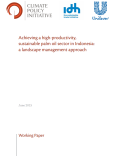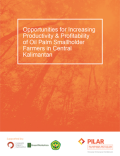This report provides recommendations on the design and distribution of policymakers and development finance institutions' policy and financing tools to enable fast and cost-effective deployment of geothermal in developing countries. It draws lessons from case studies of geothermal projects with different public, private and mixed development models in Turkey, Kenya and Indonesia.
This working paper provides a first overview of Central Kalimantan’s oil palm value chain and the business actors involved throughout. It aims to identify how business investment can be optimized to support socially inclusive development, delivering productivity, profitability, and sustainability gains.

A growing number of government, business and civil society, including Unilever and IDH, have a goal of transforming the Indonesian rural economy by 2020, to deliver net positive environmental impacts and improve smallholder farmer livelihoods. This requires a focus on transforming the oil palm sector from being a driver of deforestation, to one that is highly productive and sustainable.

The Governments of Indonesia and Central Kalimantan have ambitious targets to both grow the palm oil sector and improve environmental quality by reducing deforestation, and smallholder farmers are an important part of the picture. We find that, as the plantation area managed by smallholder farmers grows, there are opportunities to improve productivity and farmer benefits within all models of smallholder organization that we examined, particularly for individual partnership and independent farmers.
In South-East Asia a number of stakeholders are seeking to leverage green growth strategies, to reach macroeconomic and societal goals, and engage in profitable business. Through experience however, many actors have encountered numerous obstacles and challenges in financing projects, executing transactions and facilitating climate finance flows.
Focusing on financial policy and regulatory developments in Indonesia, Vietnam, the Philippines, Cambodia and Malaysia, this reports explores the different barriers that exist to private climate finance flows in the region. It concludes that capital is hindered from moving towards low-carbon infrastructure because of a number of policy and regulatory barriers, including a lack of policy consistency and alignment, potential liquidity issues in the banking sector, and structural barriers to climate finance innovation in financial markets.
